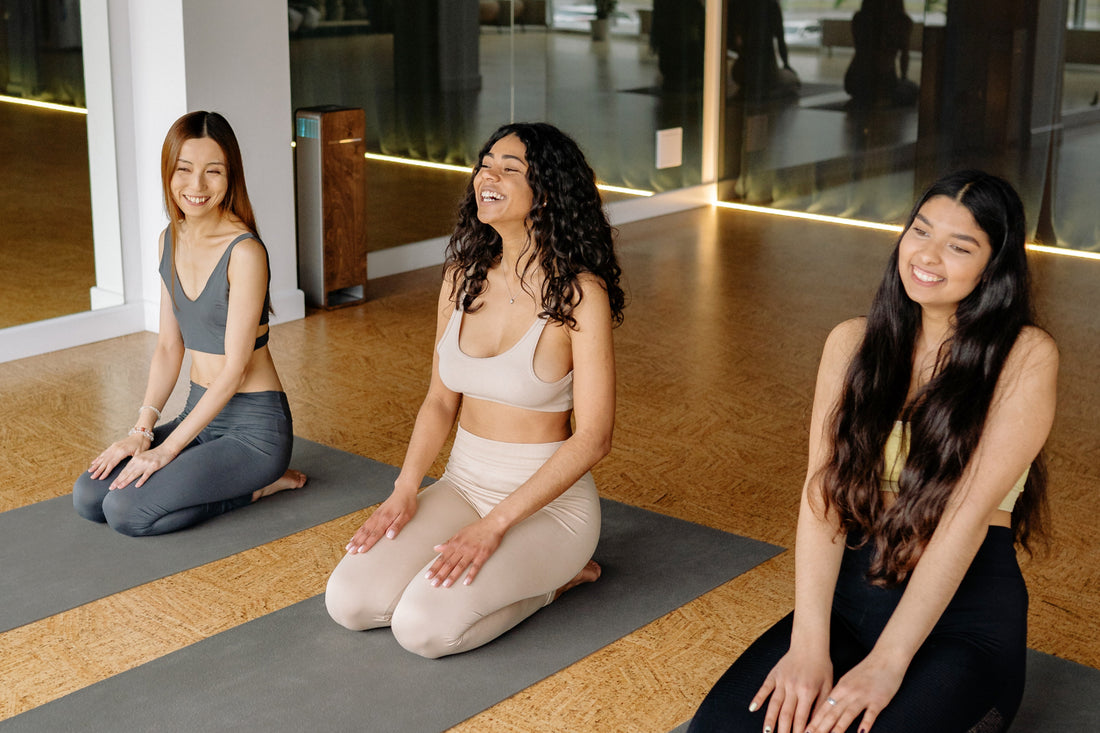Foto de encabezado de Elina Fairytale en Pexels
El yoga, que tiene su origen en la antigua India, es un sistema de ejercicios físicos, mentales, espirituales y filosóficos. Incluye el control de la respiración para ayudar a relajar la mente y el cuerpo. Su significado literal es "unión", pero en esencia significa "algo que te lleva a la realidad".
Existen diversos estilos, tipos y métodos de yoga que incluyen una combinación de posturas físicas, meditación, técnicas de respiración y relajación. Su correcta aplicación puede tener efectos mágicos en tu bienestar físico y mental, por lo que probablemente una encuesta nacional de 2017 descubrió que 1 de cada 7 adultos en Estados Unidos practica yoga.
La filosofía general es bastante simple: establecer una conexión entre la mente, el cuerpo y el espíritu mediante la combinación de posturas físicas, técnicas de respiración y meditación. Una vez que se establece la conexión, surgen los beneficios para la salud. Algunos de los principales beneficios para la salud que se obtienen al practicar yoga con regularidad incluyen un sueño equilibrado, menor estrés, control del peso, alivio del dolor, disminución o eliminación de los síntomas de enfermedades crónicas, entre otros.
En este artículo, nos centraremos en los beneficios clave del yoga para nuestro intestino y qué posturas son las mejores para promover la salud intestinal mejorando la digestión.
Beneficios del yoga para el intestino

Foto de Karolina Grabowska de Pexels
El yoga promueve un estilo de vida saludable y tiene el potencial de beneficiar profundamente nuestra salud intestinal y protegerla de diversas dolencias y enfermedades. Muchas personas practican yoga específicamente para mejorar el proceso de digestión y encontrar alivio natural.
Aumentando la diversidad de los microbiomas
Las cepas de bacterias saludables de nuestro intestino son extremadamente importantes para mejorar la digestión y mantener todo el proceso sin problemas. Hacer yoga de manera constante contribuye enormemente a aumentar el nivel de estos microbiomas favorables para el intestino.
Las investigaciones han llegado a la conclusión de que practicar yoga eleva la temperatura corporal y reduce el flujo de sangre a los intestinos. Esto genera un contacto directo entre el microbioma intestinal y las células inmunitarias y, potencialmente, diversifica la composición de los microbios intestinales.
Mejorando la digestión
Se sabe que varias posturas de yoga limpian y liberan toxinas del intestino. Otras posturas pueden actuar como un masaje para los órganos internos, lo que mejora el flujo de sangre oxigenada a varios órganos, reduce la presión arterial y facilita la digestión de los alimentos.
 Fotografía de Cliff Booth en Pexels
Fotografía de Cliff Booth en Pexels
Además de esto, practicar yoga regularmente no permite que la grasa se deposite, estira el cuerpo y los músculos, desintoxica e incluso regula el movimiento intestinal. Todo esto permite que los alimentos se desplacen fácilmente a lo largo del tracto digestivo, evitando cualquier problema digestivo como hinchazón, acidez, reflujo ácido o problemas similares.
Reduciendo el estrés
El intestino y el cerebro están profundamente conectados. Básicamente, el intestino se conecta con el cerebro a través de hormonas, neurotransmisores y mensajeros químicos. Incluso los problemas de salud mental, como el estrés y la ansiedad, tienen una fuerte relación con problemas de salud intestinal, como la acidez de estómago, la indigestión, el reflujo ácido, el estreñimiento y la diarrea, entre otros.
Las investigaciones han llegado a la conclusión de que, cuando se practica yoga de forma constante y se practica la respiración y la meditación yogui, el sistema nervioso se activa, lo que elimina la respuesta al estrés del cuerpo y mejora la salud mental. Esto, a su vez, restablece el equilibrio y la salud del intestino.
9 asanas de yoga para mejorar la salud intestinal
Existen algunas asanas (o posturas) de yoga específicas que están diseñadas para trabajar el intestino y mejorar su funcionamiento, al mismo tiempo que promueven su bienestar. Vamos a hablar de 9 de esas posturas que puedes empezar a hacer de inmediato si buscas equilibrar tu intestino.
1. Postura del pavo real o Mayur Asana
Esta asana presiona el estómago, el hígado, los riñones, los intestinos y el bazo. Al hacerlo, no solo aumenta el fuego digestivo en el estómago, sino que también mejora el flujo de sangre oxigenada en todos los órganos. También ayuda a liberar toxinas del intestino y mejora su funcionamiento, una de las principales razones por las que también se la conoce como la "postura de desintoxicación".

Para hacer esta postura, debes arrodillarte en el suelo y colocar las palmas de las manos frente a ti. Ahora gira la mano hacia atrás, de modo que los dedos queden hacia ti. Acerca las manos y dobla un poco los codos. Ahora, apóyate sobre la parte superior de los brazos mientras mantienes el estómago hacia dentro.
Levanta las piernas y deja que todo el peso repose sobre los brazos. Inclina la frente ligeramente hacia adelante, formando un ángulo agudo mientras equilibras el cuerpo. Mantén la posición durante 10 segundos y respira de manera uniforme 3 o 4 veces. Vuelve a colocar las rodillas en posición de rodillas y relájalas.
2. La postura del cadáver o Savasana
 Foto de Elly Fairytale en Pexels
Foto de Elly Fairytale en Pexels
Se trata de una postura que, principalmente, elimina el estrés y que tiene como objetivo activar el sistema nervioso parasimpático. Hacerla a diario reduce el estrés y la ansiedad y te hace sentir tranquilo y sereno. Una mente feliz y libre de estrés restablece el equilibrio entre el intestino y el resto del cuerpo.
Para realizar esta postura, debes acostarte con los brazos relajados a los costados y las piernas estiradas. Debes permitir que tu cuerpo se sienta pesado en el suelo mientras respiras naturalmente y relajas cada parte del cuerpo. Es importante mantenerte concentrado en tu respiración.
Continúe durante un rato y salga levantándose suavemente y volviendo a tomar conciencia de su cuerpo. Puede llevar la paz recién encontrada a lo largo del día y sentirse bien en todas partes.
3. La postura del arco o Dhanurasana
El objetivo de esta postura de yoga es estimular la digestión con movimientos bruscos del cuerpo. Proporciona un masaje a los órganos internos, lo que aumenta el nivel de flujo sanguíneo oxigenado. Esta asana es conocida por revitalizar el sistema digestivo y mejorar la salud intestinal.
Para realizar esta postura, recuéstate boca abajo y mantén las piernas rectas mientras estiras los brazos. Ahora levanta las manos hacia arriba y hacia atrás y las piernas hacia arriba y hacia adelante en movimientos simultáneos, como cuando haces una flexión hacia atrás de pie.
 Foto de Elina Fairytale en Pexels
Foto de Elina Fairytale en Pexels
Sujete los tobillos e inhale mientras levanta los talones. Mantenga la postura durante 15 segundos mientras se estira, respira y mantiene el equilibrio. Exhale y abandone la postura bajando lentamente la cabeza, el pecho, los muslos y, finalmente, los pies. Repita esta postura varias veces para obtener beneficios rápidamente.
4. La postura de flexión lateral sentada o Parsva Sukhasana
Esta es una postura de yoga para principiantes que todos pueden hacer. Estira los músculos abdominales, la espalda baja, la espalda alta y los hombros. Este estiramiento ayuda a aliviar los problemas de hinchazón y gases constantes, al mismo tiempo que facilita la digestión.
Para realizar esta asana, debes sentarte en el suelo con las piernas cruzadas y asegurarte de que tus manos toquen el suelo a tus costados. Ahora procede a levantar tu brazo izquierdo en el aire mientras te inclinas hacia la derecha. Mantén la mano y el antebrazo derechos únicamente en el suelo. Ahora respira lentamente de 4 a 5 veces. Luego cambia de lado y haz esto durante 5 a 10 minutos.
5. Postura de rodillas al pecho o Apanasana
Esta asana de yoga solo incluye movimientos suaves que pueden realizar todas las personas con poca movilidad. No solo alivia la tensión en la espalda baja y relaja el cuerpo, sino que también masajea suavemente los órganos internos, como el intestino grueso, lo que favorece el movimiento intestinal y el paso fácil de las heces.
Para hacer esta postura, debes acostarte boca arriba sobre una superficie plana con las piernas estiradas. Ahora empieza a doblar lentamente las rodillas y llévalas hacia el pecho. Puedes usar los brazos para tirar de las piernas hacia arriba. Ahora mantén esta posición y respira lentamente 4 o 5 veces. Relájate y baja las piernas, repite. Debes hacer esto todas las noches antes de dormir durante 10 a 20 minutos.
6. La postura del giro del vientre o Jathara Parivartanasana
Esta asana de yoga incluye realizar giros simples para mejorar la circulación y el movimiento en el proceso de digestión. Además de promover el peristaltismo intestinal, esta asana es una forma sencilla de mantener el intestino fuerte y saludable.
Puedes empezar a hacer esta postura recostado boca arriba con las rodillas flexionadas. Estira los brazos completamente hacia afuera. Levanta los pies del suelo manteniendo las rodillas flexionadas y juntas. Ahora gira las caderas y lleva las piernas flexionadas hacia la derecha.
Mantén la posición durante 4 o 5 respiraciones y luego gira las caderas nuevamente, llevando las piernas dobladas hacia la izquierda. Mantén la posición nuevamente y repite de 10 a 20 veces. Libera la posición llevando las caderas nuevamente a una posición neutral y estirando lentamente las piernas.
7. La postura de la cobra o Bhujangasana
>  Foto de Алекке Блажин de Pexels
Foto de Алекке Блажин de Pexels
Esta es una postura divertida que disfrutarás haciendo. En ella, tienes que imitar a una cobra en posición vertical. Además de la diversión, te traerá inmensos beneficios intestinales, como una mejora en la postura, el estiramiento de los músculos intestinales, la ayuda para eliminar toxinas y el apoyo al proceso de digestión.
Para realizar esta asana, debes acostarte boca abajo con las piernas estiradas, los pies separados a la altura de las caderas y las manos apoyadas en el suelo con los codos flexionados. Ahora extiende los pies, asegurándote de que la parte superior de los mismos toque el suelo. Presiona el suelo con las manos y lleva lentamente el pecho y la cabeza hacia arriba.
Ahora continúa moviendo el hombro hacia arriba y hacia abajo, de un lado a otro. Debes concentrarte en levantar el esternón en lugar de levantar el mentón. Además, asegúrate de que la pelvis permanezca en el suelo. Ahora mira ligeramente hacia arriba. No estires demasiado el cuello. Mantén la posición durante 4 o 5 respiraciones y relájate. Suéltala llevando lentamente el torso de vuelta al suelo y recostándote de nuevo.
8. Giro sentado o Ardha Matsyendrasana
>  Fotografía de Allan Mas en Pexels
Fotografía de Allan Mas en Pexels
Esta postura de yoga está diseñada para ayudar al intestino grueso y delgado en su peristalsis, lo que permite que los movimientos intestinales sean más fluidos. Estos movimientos intestinales suaves permiten que los alimentos y los desechos se desplacen fácilmente a través del tracto gastrointestinal y mantienen el cuerpo libre de problemas digestivos.
Para hacer esta postura de yoga, comience sentándose en el piso con las piernas estiradas. Ahora doble la rodilla derecha y crúcela sobre el muslo derecho. Mantenga el pie derecho plantado en el piso. Ahora, mientras se apoya en la cadera izquierda, doble la rodilla izquierda asegurándose de que el pie izquierdo esté orientado hacia el glúteo derecho.
Ahora, coloca el codo izquierdo en la parte exterior de la rodilla derecha y gira hacia la izquierda, apoyando la palma de la mano derecha en el suelo. Ahora, gira ligeramente el cuello de modo que quede sobre el hombro derecho. Mantén la posición y respira profundamente de 4 a 5 veces. Ahora, cambia de lado y haz otra serie. Haz al menos 10 series de manera similar para obtener los mejores resultados.
9. Postura del perro boca abajo con tres patas
Esta es una postura de yoga sencilla que tiene como objetivo mejorar la circulación de la sangre y el oxígeno en el cerebro para liberar todo el estrés, el miedo, la ansiedad, la tristeza e incluso la depresión. Desintoxica el cerebro de todos los pensamientos inútiles. Una mente despejada tiene un impacto directo en la mejora de la digestión y la resolución de problemas intestinales.
Para realizar esta postura, simplemente debes permanecer de pie, erguido y luego agacharte mientras estiras los brazos hacia adelante. Ahora inclina la cabeza hacia adentro y estira las caderas y las piernas hacia afuera. Levanta lentamente la pierna izquierda en el aire e inclínate hacia adelante para colocar ambas palmas en el suelo.
>  Foto de Añete Lusina de Pexels
Foto de Añete Lusina de Pexels
Ahora mantén la posición y respira profundamente 4 o 5 veces. Suéltalo bajando lentamente la pierna y repite con la otra pierna. Haz al menos 5 series con cada pierna para ver los resultados y los beneficios adecuados en poco tiempo.
Palabras finales
El yoga es una de las mejores soluciones para los problemas intestinales habituales. Al principio puede parecer abrumador, especialmente si eres principiante. Pero con la práctica regular y convirtiéndolo en un hábito, puedes dominar fácilmente la mayoría de las posturas y disfrutar de una salud mental y física óptima. Puedes comenzar con las posturas mencionadas anteriormente y ver cómo los cambios positivos en tu intestino empiezan a surtir efecto en unos pocos días.
Dicho esto, es importante comprender las propias limitaciones y tomar las precauciones necesarias. Haz solo lo que puedas y aumenta lentamente la dificultad a medida que tu cuerpo se adapte. Si tienes problemas de salud persistentes o enfermedades crónicas, busca el asesoramiento de profesionales de la salud y practica yoga solo si te lo recomiendan.


![The 9 Best Yoga Poses for Your Gut [Digest + Detox]](http://www.dyln.co/cdn/shop/articles/header_7aa46dbd-b27e-40d2-8d92-ab8e0fdbb128.jpg?v=1624929552&width=2414)



